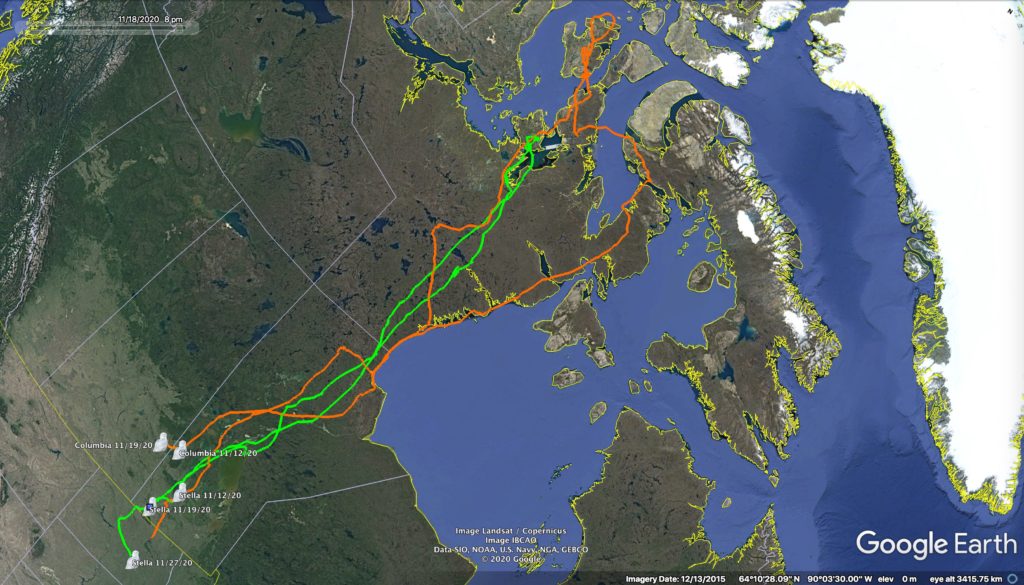
The migrations to the Arctic and back again by Stella (green) and Columbia (orange). (©Project SNOWstorm and Google Earth)
To our friends in the U.S., we hope you had a happy Thanksgiving this week, and here’s hoping everyone in the SNOWstorm community, everywhere, is remaining safe and healthy during this trying and difficult time. For all of us at Project SNOWstorm — and we suspect for many of you as well — the natural world has been a source of solace and refuge during the pandemic.
When we launched Project SNOWstorm in 2013, we scarcely imagined it would quickly grow into one of the largest and most ambitious studies of snowy owl ecology in the world — but thanks to our dedicated crew of biologists, banders and veterinarians, backed by thousands of supporters around the globe, it has.
The COVID-19 pandemic has obviously forced us to alter our plans. For example, we had hoped to deploy half a dozen or more satellite transmitters this past summer on fledgling snowies in the Canadian Arctic. However, that field work (and, in fact, most scientific work in the North) was canceled to prevent the spread of the virus to isolated bush communities, many of which know firsthand from the Spanish flu pandemic of 1918 how devastating such outbreaks can be.
That said, we are proceeding with some opportunities as we can, especially since this is shaping up to be an excellent flight year in the Northeast and Great Lakes, with a few snowy owls sighted as far south as the Eastern Shore of Maryland in early November — an exceptionally early movement that far south.
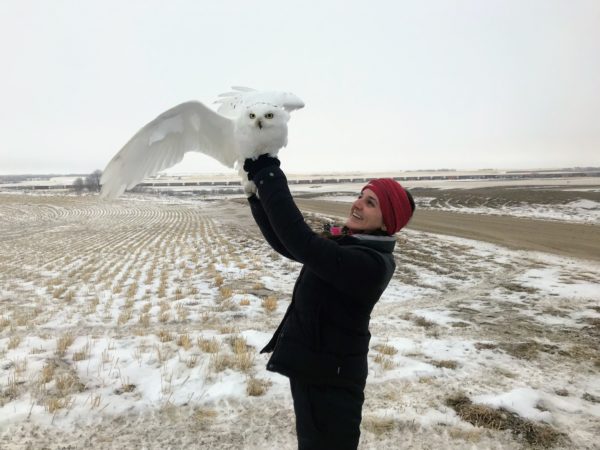
Rebecca McCabe will continue to study ways to make airports safer for snowy owls this winter. (©Becca McCabe)
One of our highest priorities remains working with airport managers to study the best ways to relocate snowy owls away from airfields so they stay away. Over the years we’ve tagged more than 40 such relocation owls at 13 airports in the U.S. and Canada. Doctoral candidate Rebecca McCabe at McGill University in Montréal is heading up the analysis of all that data. Our hope is to tag additional snowies this winter at airports in the St. Lawrence Valley and Midwest, to balance our geographic sample, which is heavy on New England locations.
The other big news is that some of our previously tagged owls are coming back into cell range and uploading all their data from the past seven or eight months. So far we’ve heard from three of our veteran owls. Simcoe, an adult female tagged last February on Amherst Island, ON, as part of our examination of how the construction of wind turbines on the island may affect snowy owl behavior, sent a brief “I’m here!” signal on Nov. 1, but wasn’t in a spot with enough cell service to transmit her location, much less any of her backlogged data. We’ll have to wait to see if she comes farther south to an area with good cell reception.
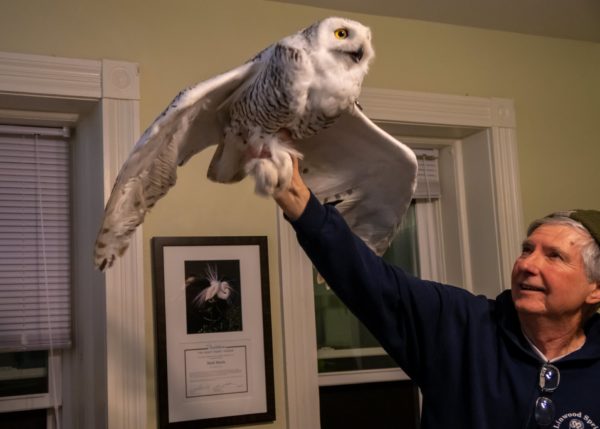
Ready to go — Columbia with Gene Jacobs at last January. (©Monica Hall)
On the other hand, we got full data uploads from Stella and Columbia, both of whom checked in for the first time within minutes of each other on Nov. 12. Columbia, you may recall, was an adult female tagged in January by Gene Jacobs at Madison (WI) Audubon’s Goose Pond Sanctuary. She headed north in April, following the western edge of Hudson Bay to the Melville Peninsula, crossing to Baffin Island, then veering west and eventually reaching Prince of Wales Island in the central Canadian Arctic of Nunavut by mid-June.
There’s no indication from the tracking data that Columbia nested, though as a two-and-a-half-year-old bird, she might still have been a little young to breed. (The age at which snowy owls usually become sexually mature is still unclear.) She had several areas where she spent weeks at a time, but never showed the singular focus on one spot for six or seven weeks that would indicate a nest.
Columbia began moving south in mid-September, again following the western coast of Hudson Bay to Cape Churchill, where she headed southwest across Manitoba. By Nov. 19 she was near Canora, in extreme southeastern Saskatchewan.
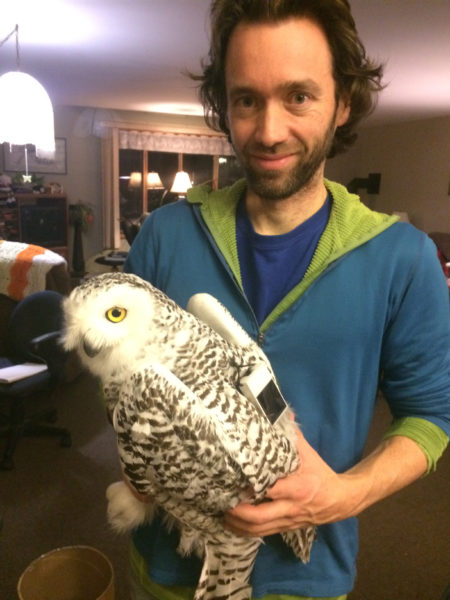
Jean-François Therrien holds Stella, then a first-winter juvenile, after she was fitted with her transmitter in 2018. (©David Okines)
Stella is another Amherst Island bird, a female tagged there in January 2018 as a first-winter bird. Her first migration north she, like, Columbia, took a westerly route, and has remained west of Hudson Bay ever since. In 2018-19 she wintered in northeastern Montana, while last winter she was in southern Manitoba just north of the U.S. line, at Whitewater Lake near Boissevain.
Her new data shows Stella migrated north through Nunavut, though not going quite as far as Columbia; instead, she fetched up on King William Island in the Beaufort Sea. Here again, there is no evidence that she nested, and likely for the same reason — she just turned three this summer, which may or may not be old enough to nest. Stella also began moving south in mid-September, and she appeared to be making a beeline back to Whitewater Lake, where she wintered last year.
Instead, this past week she continued on to the south, through Stutsman County, ND, an area where longtime SNOWstorm team member Matt Solensky does a lot of his snowy owl banding. Matt might be feeling a little paranoid these days, as Stella flew almost directly over Matt’s house on her way to her last location on Nov. 27, in Barnes Co., ND.
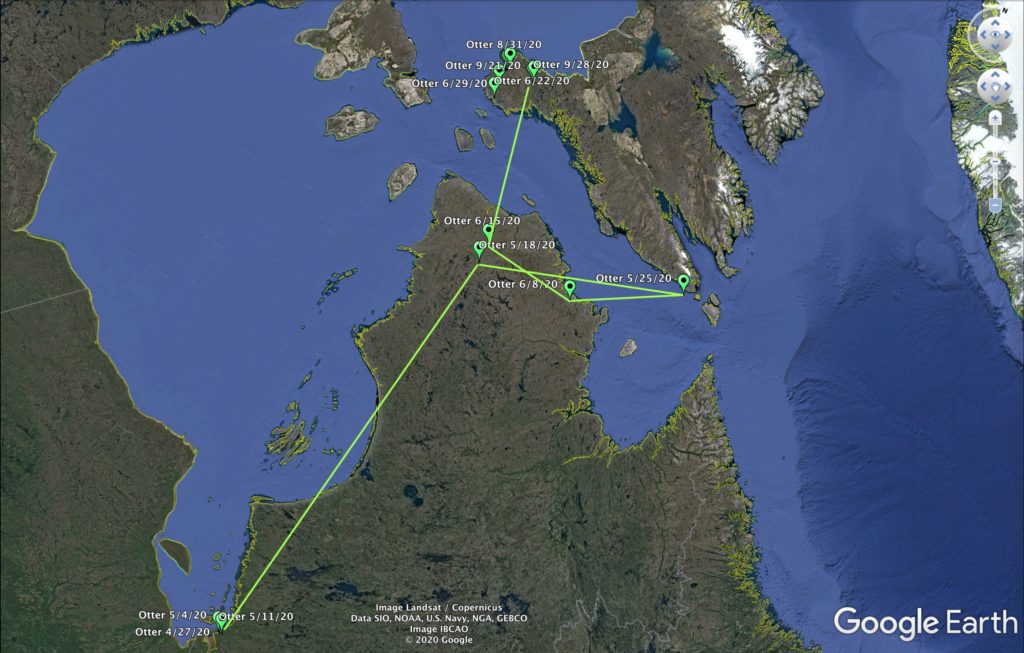
Otter’s migration route north in May and June to the Foxe Peninsula of southern Baffin Island, based on Argos data. (©Project SNOWstorm and Google Earth)
Thanks to his hybrid GSM/satellite transmitter, we were also were able to keep track over the summer of Otter, the adult male tagged a couple of years ago in New York, and who wintered last year near Montréal. He spent the summer on the Foxe Peninsula of southern Baffin Island, just across Hudson Strait from the Ungava Peninsula. When the unit is out of cell range we only get a few locations once a week, just enough to see where the bird is, but not enough to say if, for example, it was nesting. If Otter comes back south to cell range, as we expect he will, we should get a full data dump of all his stored GPS locations, which will give us a very clear picture of his summer. (Until then, his interactive map does not include his summer Argos satellite data.)
So, lots of exciting developments already, and the season is just getting started. As always, we’ll be updating you all regularly — and as always, none of the work we do would be possible without your donations, which provide 100 percent of the support we receive for Project SNOWstorm. We realize this year is very difficult for a lot of our friends. If you’re able to make a contribution this season, we’re even more grateful than usual. If not, no worries — we’re still glad you’re along for the ride, and you can help by sharing the work we’re doing with your friends and families.
Stay safe and well, everyone.


20 Comments on “A New Season Amid Unusual Challenges”
So happy to hear from you and excited to see what is in store for Snowies this winter. Of course, living in NJ, I am hoping to hear about snowies who have visited NJ. Thank you for your hard work and keeping us informed.
Good to hear some of the tagged birds are checking-in, as I was getting a bit nervous about this season being a slow one. Here in eastern North Dakota (and north into Canada), eBird mapping of sightings had seemed quite slow in October and early November, even though I had heard about several Snowies that never showed up on eBird from non-birdwatching sources. The map has gotten more active in the last week, so now I’m wondering if it was more a Covid19-caused lack of bird watchers than a lack of birds that was causing the slowdown. As many birders do their birding in pairs or small groups, Covid19 could be putting a crimp in this activity even though it’s primarily an “outdoor sport”.
Some birders may not be reporting on these charismatic species like Snowys. Last winter, near where I live, we had 8-9 individual birds in a small area in eastern WA. Turned into a feeding frenzy of photographers & visitors that created conflict with landowners. I actually avoided posting any photos until it became widely known. Right now in Seattle a young bird is roosting on roof tops in the Queen Anne section of the city. I’m hoping that we get some winter visitors – seeing the Rough-Legged Hawks now.
Depending on where the owls show up (generally in more southerly areas where snowy owls are less common, such as the lower mid-Atlantic region), eBird reviewers may at least temporarily mask the location to protect the owl from too much attention and pressure.
I am glad to hear that the snowy owls are on the move.. I thought it was going to be a slow year also .
Hoping and looking forward to their arrival near Erie Pa. area.
Glad to hear from your org. we here in Ohio have had several reports one around Sandusky, Ohio believe that one had something wrong with it. One around Oberlin, Ohio and another sighting at Alum Creek near Columbus, Ohio Do you think there will be an uptake in them this season.
Glad to see you’re back reporting! Love seeing the updates.
I also follow a number of bird rehab facilities here in Northern Michigan and the Upper Peninsula who have already reported that they’ve received snowies who have been in very poor condition (who sadly didn’t survive) following their long journey south.
Thanks for all you do.
It seems to often be the case that among the first individuals to arrive during a flight year are a number of birds in compromised condition that wind up in rehab — that’s been the case in Michigan and Pennsylvania also this month. But our veterinary team has found that during major flight years the large majority of snowy owls that come south are in excellent health.
I have moved back to the Pacific Northwest after several years in the Mid Atlantic region. We’ve had a snowy in a Seattle neighborhood for a couple weeks now. Any projects out this way?
We’ve been looking into ways to make the most of the next big irruption into the Pacific Northwest, though there hasn’t been one since we started SNOWstorm in the winter of 2013-14. We’re keeping our fingers crossed, though.
Hi
We were excited to learn that “our” owl Columbia is back in the USA. We and eveyone at Madison Audubon look forward to tracking her movements this winter.
Thanks to Project SNOWstorm volunteers for all their work on learning about snowy owl ecology.
https://madisonaudubon.org/fff/2020/1/31/we-named-her-columbia
Mark and Susan-Foote Martin, Resident Managers, Goose Pond Sanctuary, Arlington, WI 53911
And thanks for Madison Audubon’s support through the years, Sue and Mark!
Very few, if any here on Cape Cod yet, but they are certainly irrupting into MA, and have been. Expecting Cape visitors soon. Fortunately, birders are doing their best to protect the locations from the throngs.
Glad to hear , tracking back to US ,, we have had a few frequent Buffalo Boat Harbor every year , I reported thru Ebird already this year , seen 2 myself .
Above, two folks out this way (Seattle) have mentioned our visitor “The Queen” (as I am calling our singular SNOW). Since late Oct (first reported on Tweeters was 10/27), we have had a single, non-juvenile SNOW gracing our eyes and hearts in the Pacific Northwest (NW Washington state to be exact) – seen in Burien, West Seattle, Ballard… and now here on Queen Anne hill. Remarkably, she has decided to designate her “day-camp” a 3 block radius at the top of this landmass since Nov 14. This sage of over a month now is one singular individual SNOW… by her markings carefully compared from multiple photos, and secondarily there being no sightings of two, day-time sedentary birds. From my study of guidelines to distinguishing male vs female and general age (thank you for the clues on this site – wish I could see molt limits!), I like referring to our Visitor as “she” … well, she’s on Queen Anne and is wearing her tiara too. I just can’t describe the wealth of joy, awe and curiosity stimulated in the many COVID-compliant and needy souls she has touched here!
Scott, should there be no further visitors from the north out in this ‘time zone’ in the next months, it would not seem right to call this part of an irruption. Could you share a few theories and thoughts on these rare solitary visitors such as this one, The Queen? Thank you so very much, in advance.
Elaine,
Snowy owls have arguably one of the most complex movement patterns of any bird on Earth — from nonmigratory, year-round residency in the Arctic; to highly nomadic movements between both breeding season and wintering sites; to reliable, annual migration to established winter territories. As our SNOWstorm colleague JF Therrien likes to say, snowy owls didn’t read the normal bird rulebook. So even though there hasn’t been a big irruption in the Northwest in a number of years, there are usually at least a few snowies that make it south along the Pacific coast each winter — probably more than are detected by birders. In the case of “the Queen” in Seattle, she’s obviously found a great spot, as she spent the whole winter there. Fingers crossed that she comes back again next winter.
I was able to see the snowy owl at alum creek dam in Columbus Ohio it was sitting on the rocks at the levee on the south side of the dam. It had been there several days and appeared to be in good health. It was alert and looking all around. Several pictures had been posted on Facebook but I was thrilled to see it for myself. It’s only the second snowy I have ever seen
So excited to hear from Project Snowstorm. As always it feels like we are welcoming friends and family back home after a long separation – and of course, doing it from the appropriate distance. We have missed your reports, and look forward sharing them again! Thank you for this vital work and for education us all about these amazing birds.
I have just heard that there has been a siting on Nov. 11, 2020 at Gulls Point located in Presque Isle State Park , Erie Pa.
Also another siting of a different snowy owl in the Olean N.Y. area .
Glad to see some of the SNOWstorm snowies are starting to head south. No idea how I missed this update…Good to hear from Stella, we had the pleasure of seeing her a few times the year she was in Amherst Island. We were in the island a few weeks ago, no snowies sightings yet but we got to see other birds.
Thanks for all your hard work and for keeping us informed!!